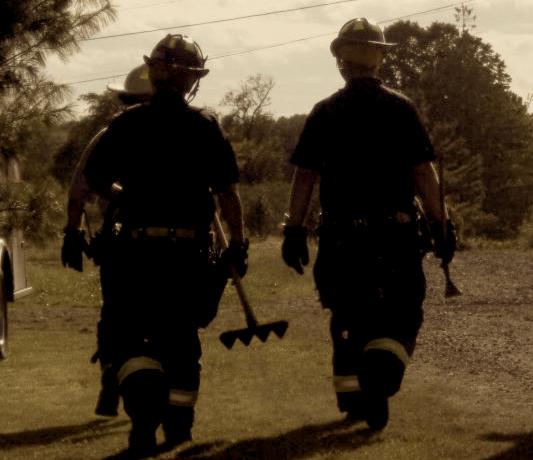Bill Packard: Bottom line, don’t run out of water
The biggest issue for any rural volunteer fire department is water, or lack of it. Unlike urban areas, rural departments have few or no hydrants and if they do have hydrants they usually flow very little water.
Having said that, very little water available by just opening a valve is pretty valuable compared to laying long hose lines to rivers of ponds or hauling water in tank trucks.
Firefighting is really a numbers game. If it takes 750 gallons a minute of flow to extinguish a fire and 250 of it come from a hydrant, that only leaves 500 that you have to find someplace else.
For most rural departments hydrants are something you see when you visit the city. One of the strategies we used in our hydrant area that worked OK was to set our portable tank up next to a hydrant and flow the hydrant into the tank. Then, the tankers would dump water into the same tank, but there was always 250 gallons a minute going into the tank that was water they didn’t have to haul.
Water is a huge deal when you have to go looking for it, so it’s important for volunteers at any level to know where the water is.
Sometimes, you may be operating the apparatus and the command will be given to go to the water. You either need to know where that water is or figure it out.
We went around to every water source, measured 900 feet and painted a 1 on the road. Since 1,000 feet of large diameter hose is about all you should lay between pumpers, a pumper could stop at the 1, drop the line and reverse lay to the water, knowing they would not run out of hose. I think the 1s have been long gone for a while.
Everybody in the fire service busts everyone else’s chops. The Chief and I always took heat for having lots of mutual aid apparatus for what often was a relatively small fire. Here’s how we looked at that: When you arrive on a fire scene and there is no life threatening situation, your responsibility is to save as much property as possible. Property. While you should never run out of water, if something went wrong and you did, you would lose some property.
Once you introduce firefighters into the building, you now have lives to protect and that is not something to be taken lightly. Several fire engines idling on the side of the road are not hurting a thing, but if the fire suddenly extends or a piece breaks down or a line breaks, you need that extra apparatus to protect those firefighters.
The Chief and I also always looked at the size of the building rather than the size of the fire. A small fire in a huge building could become a huge fire in a huge building and that’s no time to be calling for help from another town. Much better to have them just up the road.
We also got a lot of heat from our department members for calling for big attack lines. Inch and three quarter lines are pretty much the standard for fire attack and they work great in a lot of situations, but sometimes they can put firefighters in danger because they are not flowing enough water to extinguish the fire and they don’t know it.
We had a call for a vehicle fire one night and it was about five miles up a side road and about eight miles from the station. The fire had a good headstart and was ripping pretty good when we got there ahead of the engine.
When the crew arrived, they were going to pull an inch and three quarter line, but we called for a two and one half line. Groaning and grumbling, they pulled the line and almost instantly put the fire out. No danger to them and no danger of extension or tires or fuel tanks exploding.
Firefighters being firefighters, the quick knock down was not as important to them as the extra work it took to load the larger hose.
Over time they came to expect it. I don’t think they ever liked it, but knew it was coming. One more thing about hose lines. If you arrived later in the fire or served in some support role, take over the picking up of lines. Don’t let the guys or gals that were on the lines putting out the fire be the ones that have to pick them up and clean and put things away at the station.
I mentioned earlier about not running out of water. Water management usually goes to officers, but in a volunteer department anybody could be making water supply decisions, especially early on.
It usually takes some time to establish big water at rural incidents so it’s important to manage your water from the start.
As a firefighter, you may determine that it’s going to take master streams and many handlines to get control of the fire you just rolled up on and decide to feed a monitor and put big water on the fire upon arrival.
That’s fine if you’re sure water will keep coming out of that device until the fire is out, but remember that all the rubberneckers have their phones out and you will be on Facebook in minutes. So maybe a hand line or two that are really not making any impact on the fire will look better on the iPhone that is recording the incident than no water going on the fire at all.
One last thing. If you’re interviewed by the media, don’t say you ran out of water. Say you had challenges establishing a water supply or something like that. Bottom line,though. Don’t run out of water.
Water is a big deal at a fire.
More Bill Packard
Volunteer firefighting is one of the most rewarding, fun things anyone can do if they’re on a department with the right culture. My hope is that these stories can create enough interest in even one person to join a local department and feel the satisfaction that comes from being a firefighter and understand what makes it so special.
Bill Packard lives in Union and is the founder of BPackard.com. He is a speaker, author, small business coach and consultant.
Anything you save is important
Wires down, people trapped... and the night half the county went dark
Event Date
Address
United States
























